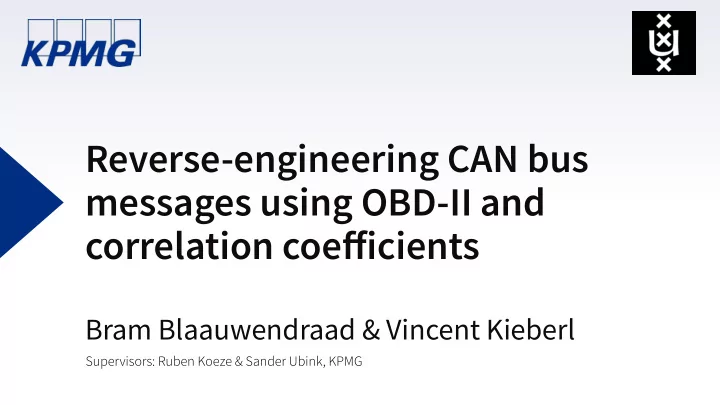

Reverse-engineering CAN bus messages using OBD-II and correlation coefficients Bram Blaauwendraad & Vincent Kieberl Supervisors: Ruben Koeze & Sander Ubink, KPMG
What is OBD-II? On-Board Diagnostics II ▸ High level protocol that provides access to status and stored error codes ▸ of vehicle sub-systems PID (hex) Description Parameter identifiers (PIDs) ▸ 05 Engine coolant temp. 0C Engine RPM 0D Vehicle speed 10 Mass Air Flow rate Source: SAE J1979 / ISO 15031-5:2015 2
What is CAN? Controller Area Network ▸ Bus network: broadcast ▸ Saves on copper wiring costs ▸ CAN IDs identify message types ▸ not public information ▹ Most CAN IDs occur regularly ▸ Meant for closed systems → insecure ▸ 3
Automotive IDSs Increasing amount of electronics in vehicles ▸ IDSs currently use features from traffic metadata 1 ▸ Content-based features may improve accuracy ▸ Data plausibility checks ▹ 1 Bresch, M. and Salman, N. Design and implementation of an Intrusion Detection System (IDS) for in-vehicle networks. Gothenburg: University of Gothenburg, 2017. 4
Prior work: Kang et al. Automated reverse-engineering of CAN frames using OBD-II ▸ Matching OBD-II value to CAN data ▸ Process of elimination ▸ Source: T. U. Kang, H. M. Song, S. Jeong and H. K. Kim, "Automated Reverse Engineering and Attack for CAN Using OBD-II," 2018 IEEE 88th Vehicular Technology Conference 5 (VTC-Fall) , Chicago, IL, USA, 2018, pp. 1-7, doi: 10.1109/VTCFall.2018.8690781.
Prior work: Kang et al. (2) Only search for one-on-one matching value ▸ Initial experiments show that in Audi A4 B7, translation is used ▸ Approach Kang et al. does not work for translated values ▸ 6
Source: https://wiki.openstreetmap.org/wiki/VW-CAN 7
Research question To what extent can we reverse-engineer CAN messages using OBD-II interrogations and correlation coefficients when a translation is used? 8
Methodology: theory Start listening on CAN bus 1. Do OBD-II request for supported PID 2. Stop listening on CAN bus 3. Compute averages for every unique CAN ID + byte index pair 4. Calculate Pearson Correlation Coefficient [OBDdata][CANdata] 5. 9
10
11
12
13
Methodology: practical Audi and Hyundai ▸ 100 / 200 interrogations ▸ Testing procedure ▸ 14
Methodology: proof-of-concept Python 3 ▸ Multithreading ▸ Get CAN data asynchronously ▹ Steps Get supported PIDs 1. Get CAN and OBD data for each PID 2. Compute averages 3. Compute correlation and save to CSV 4. 15
Methodology: fitting Reverse-engineer formula used on CAN data ▸ When correlation > 0.9 ▸ We assume ▸ Fit value in 8-bit integer and allow negative values ▹ E.g. COOLANT_TEMP = ▹ 16
Results PIDs with High correlation on all tests ▸ Examples: ▸ PID CID + Byte Index (int 100 & 200) Correlation Audi RPM 0x280 - 3 ~0.997 Audi INTAKE_PRESSURE 0x588 - 4 ~0.999 Audi MAF 0x288 - 6 ~0.962 Hyundai COOLANT_TEMP 0x329 - 1 ~0.992 Hyundai THROTTLE_POS 0x329 - 5 ~0.972 17
Results (2) PIDs with no matches (correlation < 0.9) ▸ Examples: ▸ Audi - ENGINE_LOAD ▹ Audi - INTAKE_TEMP ▹ Hyundai - AMBIENT_AIR_TEMP ▹ Hyundai - EVAPORATIVE_PURGE ▹ Potentially a combination of CAN values (e.g. 0x280-2 + 0x360-4) ▸ 18
Results (3) PIDs with ambiguous result ▸ Example: ▸ COOLANT_TEMP on Audi matches on both coolant temperature and ▹ oil temperature In certain driving conditions, these behave almost identically ▹ Different testing procedure solved this problem ▹ 19
Result (4) Exact formula not found, however: ▸ Close approximation when range ▹ is known Lower resolution through averages ▹ Still useful for IDS Suspected Formula ▹ Found Formula 20
Discussion It works, however... Practical considerations: What parameter are you looking for ▸ Fluctuations in environment variables ▸ Amount of CAN messages in test vehicle ▸ Thus: not one optimal setup 21
Conclusion Correlation can be used to map CAN ID and byte indices to OBD values ▸ and formulas can be approximated with some limitations. Limitations ▸ No correlation (possibly a formula) ▹ Testing Procedure matters ▹ 1 on 1 match will not be found (correlation = n/a) ▹ Only works on one byte values (max. 255) ▹ 22
Future work Bigger sample size ▸ Limited through OBD port, (security) gateways ▹ Conclusive proof ▸ Reverse-testing ▹ Extensive testing procedure ▸ Performance ▸ 23
Recommend
More recommend